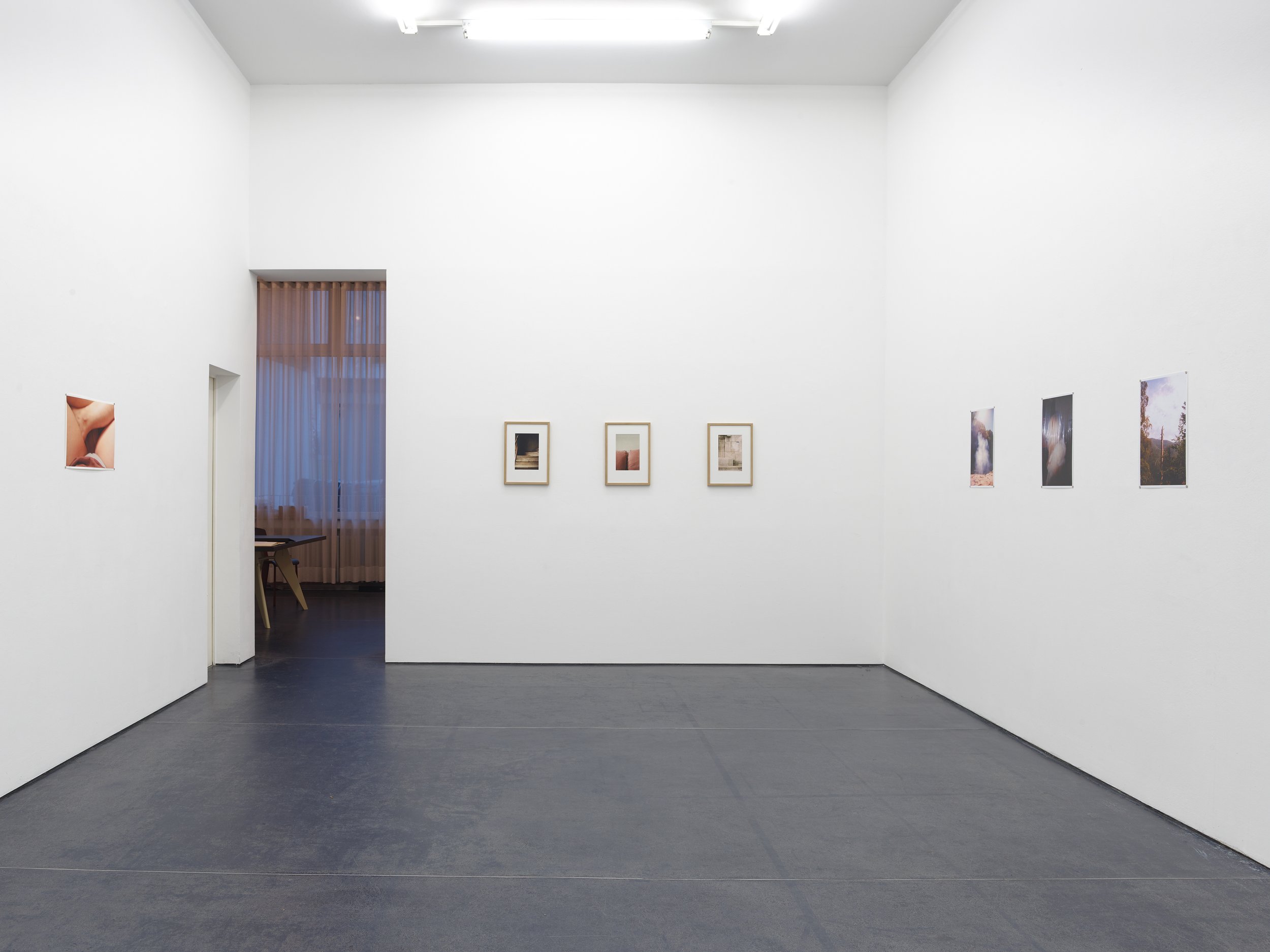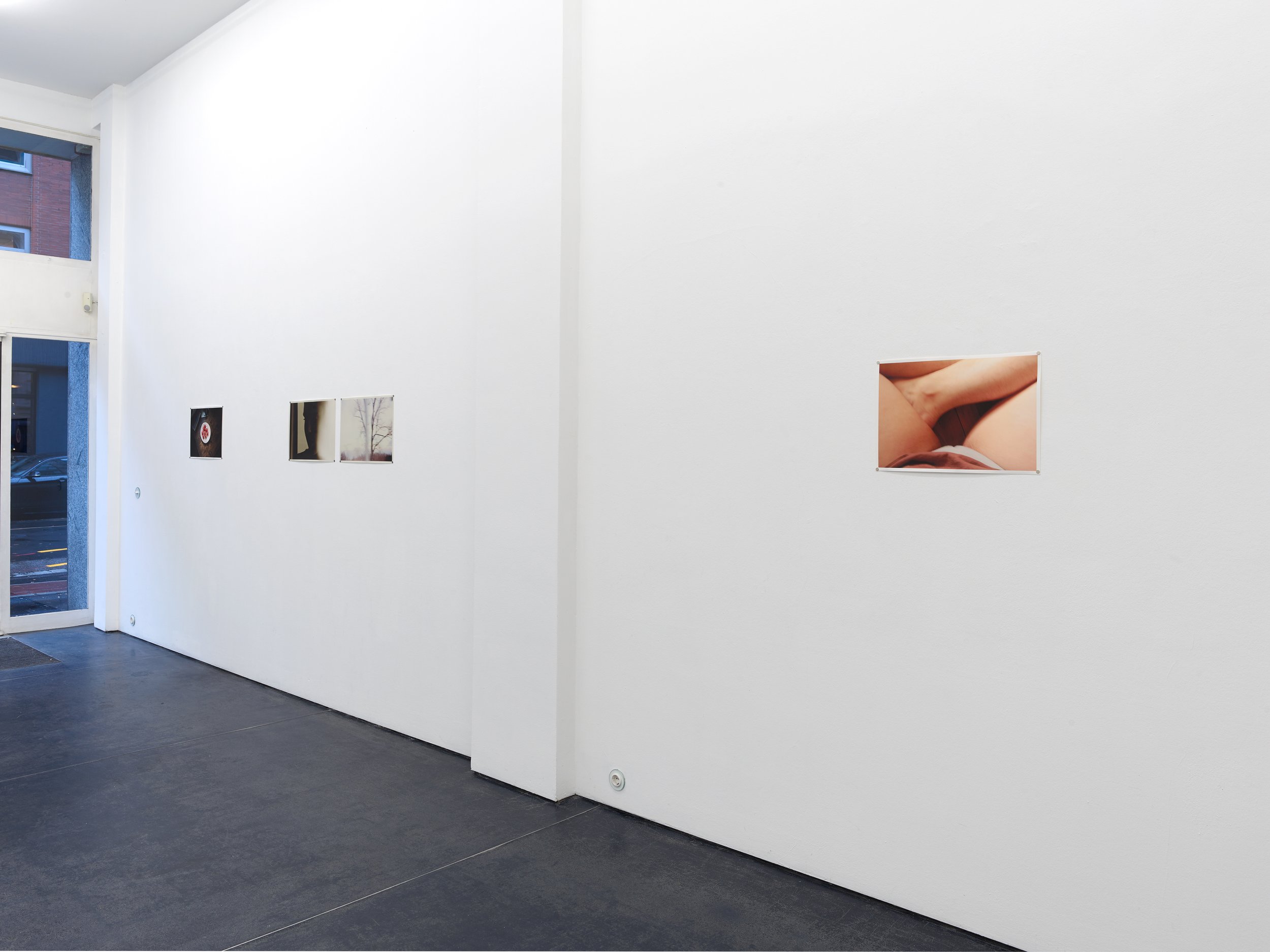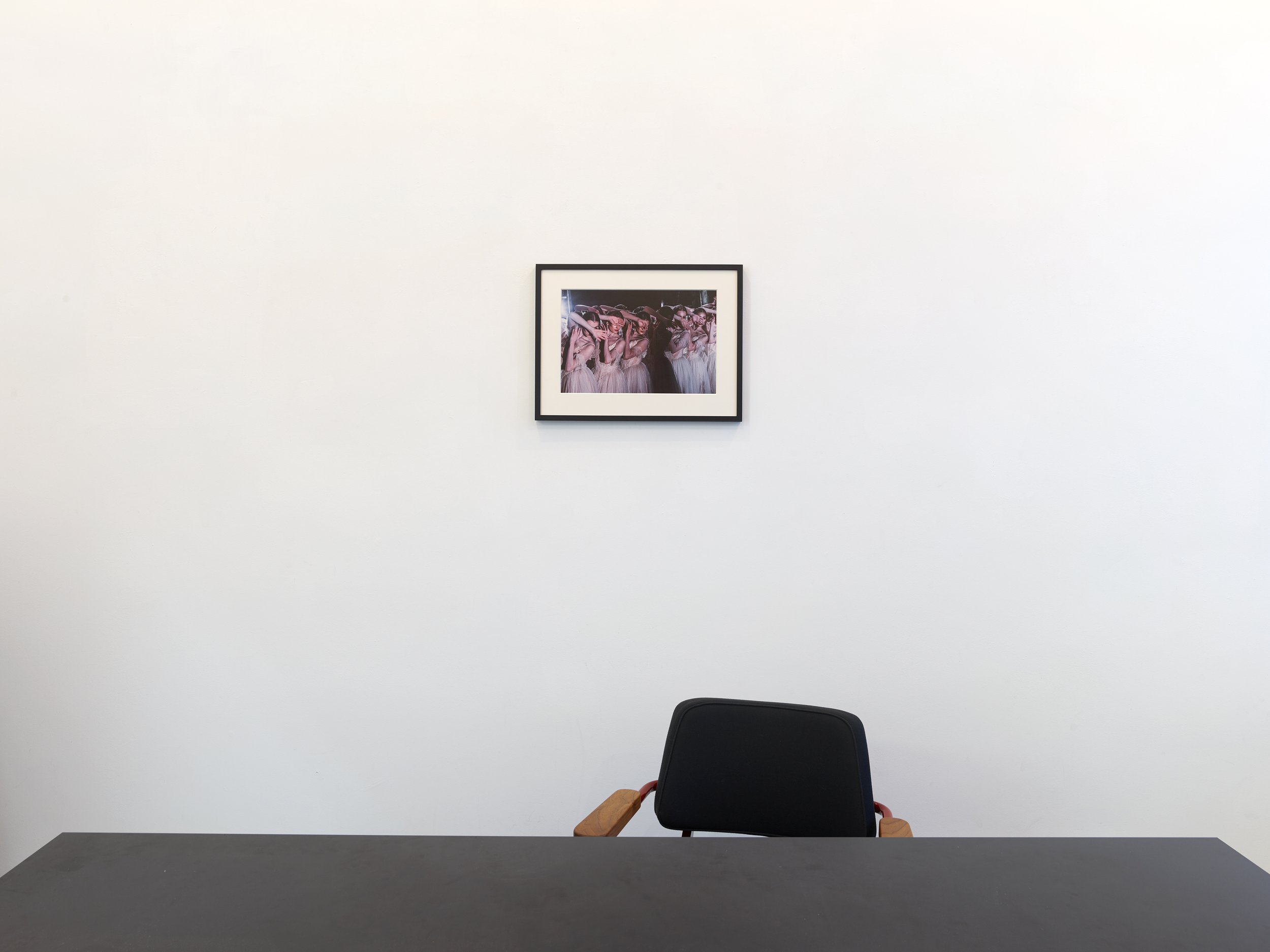Dolly Brown, Rivkah Gevinson, Ruby Squires, Isabelle Young
INVOLVING OURSELVES
GRUPPENAUSSTELLUNG 12. Oktober - 9. November 2019 KÖLN
Ausstellungsansichten © by Simon Vogel, Köln
Ausgewählte Werke (zum vergrößern auf Foto klicken) © by Simon Vogel, Köln









Ausgewählte Werke (zum vergrößern auf Foto klicken) © by Simon Vogel, Köln
Galerie Norbert Arns presents Involving Ourselves, an exhibition curated by Isabelle Young, featuring four photographers who share a peripheral perspective of a subject and explore a sense of privacy. A central observation of which all four photographers are keenly aware is a comment by the writer and curator Gerry Badger, who remarks that ‘in general, painters begin work in the middle of the canvas. Photographers begin with the edges of the frame’.
Dolly Brown’s perspective resides in the wings of the stage. Gaining access to the sacred behind-the- scenes areas of London’s Royal Opera House and Sadler's Wells, she documents what the audience can never fully see: The Royal Ballet's corps de ballet turning away from centre stage and facing into the wing, or a Royal Opera House assistant drawing back a curtain for the principal dancers’ curtain call. With the same intimacy, Brown photographs painters at work in their studio. Not only does she capture the canvas acting as a stage for a painterly performance – as seen in her recent visits to painter Erin Lawlor’s studio – she also emphasises the artist’s private working space.
Rivkah Gevinson uses the camera to seek out and emphasize the gesture, light and color that assembles a moment. Photographing in the every-day, she finds her images like ephemeral still lifes, at once personal and incidental. “When photographing a landscape, I am both immersed in myself and what is in front of me," she notes, her often abstracted images – blurred scenes and dissolved picture planes – give a sense of self in one's surroundings.
Ruby Squires captures the fleeting but charged moments that mark the young friendships that define us, alongside an intimate depiction of the natural landscape. Squires’ upbringing within a rural environment is clearly visible; parallel themes emerge in the dialogue created across the pairing of images. The arms thrown into the air wave at something below, but seem still and posed; a cloud of smoke appears as though on cue; and plastic sheeting envelopes a young girl - who may have been equally unaware of the photographer as Squire’s other subjects. Together they are subtly emblematic of a time and age in life.
Influenced by the architectural aesthetic of Northern Italy, Isabelle Young captures her subjects through closely cropped and fragmentary details. Focusing on the surrounding areas of well-known historical landmarks, Young highlights the charged ambiguity of peripheral spaces with a quiet and focused attention to detail. Her work often comprised of a painterly palette of faded tones, the artist derives much of her sources from Italy which has since informed a wider series across Europe, and more recently, Los Angeles. Drawn to the soft pink tones of a French beach scene or the timeworn cushions in painter Celia
Paul’s London studio, Young is constantly aware of confidence in concealment, in both herself and the subjects she captures.
The female gaze and personal experiences are at the core of these works, revealing an awareness of how women feel continuously perceived by others both as subjects and in the act of taking a photograph. Each photographer pays attention to the periphery to explore how women themselves have often existed within this space, their work holding and capturing what is missed.
Dolly Brown (b. 1976) is an artist based in London. Her work explores the process and presentation of artistic practice. She has worked with The Royal Ballet, Barbican, Tate Modern, Trisha Brown Dance Company, BalletBoyz, Mark Morris Dance Group, Sadler's Wells and Darbar Festival, among numerous others. In 2016 she was named by Aperture Foundation as one of 11 photographers to follow on Instagram and completed a residency with the Barbican, London in January 2017. Previous exhibitions include The Great Women Artists: Women on Instagram, Mother, London, 2017; For Since a Woman, St John of Bethnal Green / Plinth, London, 2017; Free Range, London Institute of Photography, 2017-2018; and Dear Photography, Hamburg, 2016.
Rivkah Gevinson (b. 1990) is based in New York and Oslo. Recent projects include a photobook Leaver, Returner, 2019 and a short stop-motion animation Be Home Soon, 2018. Gevinson's work has been exhibited in Norway, Germany, Northern Ireland and New York. She holds a B.S. in photography at Skidmore College, and was a resident artist at Atelier Austmarka, Norway in 2016, and the Edward Albee Foundation, Montauk, NY in 2017. She is the project manager for After Dark, a publication by Hilton Als.
Ruby Squires (b.1991) is a UK-based photographer working with film and analogue processes. She studied for a Foundation in Art & Design, Chelsea College of Arts, 2012 and a BA in Photography, Arts University Bournemouth, 2015. Previous exhibitions include Ladylike, Open Space, Bournemouth, 2013; Voyage, Anteros Art Foundation, Norwich, 2016; Holiday Snaps, Norwich Playhouse, Norwich, 2016; Homework, The Crypt Gallery, Norwich, 2016; More Homework, The Crypt Gallery, Norwich, 2017; Deadline, The Crypt Gallery, Norwich, 2018.
Isabelle Young (b. 1989) is a London based curator and photographer, currently studying for a Photography MA at the Royal College of Art, London. Recent exhibitions and projects include the Artist Residency at Palazzo Monti, Brescia, Italy (September 2019); Art For Youth, Mall Galleries, London, UK, 2018 and Overhaul, Peckham 24 Photography Festival, London, UK, 2018.
Exhibition
This exhibition will bring together the work of four female photographers to explore a sense of privacy within our work. I have always noticed a confidence in concealment, in both myself and those I capture therefore the exhibition will specifically explore how privacy manifests itself in both my portraiture and architectural works alongside the photographers I have selected to exhibit.
The writer and curator Gerry Badger commented that ‘in general, painters begin work in the middle of the canvas. Photographers begin with the edges of the frame’ - an observation which all four photographers are acutely aware of when making an image.
These works share a peripheral perspective of a subject, averting any depiction of grandeur, working from the edge instead of the centre. The work of Dolly Brown in particular resides in the wings of the stage, documenting what you will never see when watching a staged performance. Isabelle Young captures the essence of a subject through closely cropped, fragmentary details. Influenced by Italy and her Italian heritage, her photography explores the formal periphery as a place of freedom and ambiguity with a domestic attention to detail. Rivkah Gevinson abstracts her subjects through literal blurring of her images and dissolving the picture plane. She often repeats a subject with her images harkening back to each other. Our work is always a conversation with itself and sometimes the movement is not always forward. Ruby Squires captures the fleeting but charged moments that mark the friendships which define us, alongside an intimate depictive of the natural landscape.
The exhibition will therefore present an underlying exploration of how women have themselves existed in the periphery. The female gaze and personal experiences are at the core of these works, revealing an awareness of how women feel continuously perceived by others.
Artist Statements Dolly Brown
I have always been interested in artistic process and how cultural products and meaning are created. In some ways, the process is more interesting to me as a visual subject than the finished product. The wings of a stage, as a locus, are a physical metaphor for that process of becoming. It is a liminal space where the unseen part of the performance takes place, the part that is ‘out of frame’. It is the private part of a public performance.
When I’m in the wings of a stage during a live performance I’m always conscious of what a great privilege it is. The dance companies that allow me to observe and document from that perspective are placing a great deal of trust in me to be there at all and of course to make thoughtful images that say something
about the art form. As such, I am always astute to be respectful of the surroundings and above all the dancers. The last thing I would want to do is to intrude on what are ultimately private moments of preparation, mental and physical, before a dancer goes onstage. As such, many of my images make a virtue of my desire to melt into the surroundings and not to become the subject myself by seeking to impact the scene. Dancers are often seen from the back, half in shade and half in light.
The other aspect of my work with dance and dancers is to show a performance from a perspective that the audience would not normally see, but in a way that embodies not the way a performance looks, but the way it feels to watch it.
Another aspect of my practice explores the presentation of art in institutions, in which I document the ‘backstage’ elements of art museums and galleries. I worked with the Hayward Gallery in London to document the installation of their “Space Shifters” exhibition, showing essentially private views of the museum as various sculptural works were installed prior to the opening of the show. The work in this exhibition seemed particularly apt for this treatment, given how impeccably machined and fabricated some of the art works were. To show these magical-seeming objects slightly ‘undressed’ was a great pleasure.
Rivkah Gevinson
Regarding my use of focus and blurring a landscape, I have been thinking about this while I’ve been in Norway. The landscape painter Amy Talluto commented that every genre comes with its baggage, and that the baggage of landscape is the vacation vista, which, as an artist, you have to push past.
When I connect with a landscape, I feel it so strongly, and these are the only landscapes I can photograph. Such a connection makes it so that I can't fake a photograph; I just can't find the technically "best" way to display the landscape. If I made photographs of these landscapes that framed them like postcard landscapes, I would be so ashamed. I have to really find it through more personal means. This might involve blurring, or something else. I have been photographing in Norway since 2010, and started to really think about how I could do it in 2013 when I travelled throughout the country on a photography trip across 3 months. I wanted complexity and layers, akin to the music I was listening to at the time of Yo La Tengo. When I closed my eyes and listened, I felt like the sounds were coming from all angles and making these weirdly (but not randomly) composed paintings.
And then there is the element of immersion and the private when it comes to photography. When I’m photographing in a landscape I am both immersed in myself and in what is in front of me. I’m not immersed in my thoughts, my mind is kind of blank and things float through, usually thoughts or ideas that interest me. But it is a deeply private space. I cannot photograph landscapes in the company of others. I can’t connect properly be with the place if I’m with another person.
And somehow a blurred focus lends itself to both expressing immersion and also to helping me immerse. Out of focus, you cannot concentrate on details, but you can concentrate on waves: waves of color, colors
moving in an out of each other, light taking over. I have really bad eyesight therefore without my glasses everything is a blur and individual lights are big glowing orbs. Looking at solid objects is funny because they're not solid anymore, they lose their form depending on the light. Sometimes I feel I see better without my glasses. I'm less distracted, and I can see the colors clearly and feel I really am where I am.
Ruby Squires
My work explores female connections, our connection to friends, family and our environment. These stories are told within the moments I capture but also in the spaces between them and the way I chooses to pair images. Themes of becoming, transition and both emotional and physical change underpin my practice. My belief in human’s inherent connection to nature is clearly visible, but the themes emerge in the interaction of images sat side by side and the dialogue created in the physical space of a book or exhibition space.
Isabelle Young
I often think about privacy, which manifests itself across both my portraiture and architectural photography
with a domestic attention to detail. My work explores architecture and architectural interiors, classical subject matter and its origins - influenced by Italy and my Italian heritage.
Regarding my architectural work, what draws me to certain Italian cities is the fact that I can still see and photograph the country my family’s generation grew up around because, in a large part, it still exists. The upheaval surrounding the Italian landscape and Italian society between the seventies and eighties is one I perceive as still visible, and have actively investigated in my own work within a contemporary context.
My portraiture in turn focuses on a moment of contemplation or distraction, avoiding a mutual self- awareness between both subject and photographer through a more observational approach to portraiture. For instance, the three women observing the Saharan dust which momentarily bathed London in a yellow light (there is no filter on this photograph).
Studying painting has also been a significant influence; in works I am intensely familiar with as a whole, details have always been more captivating, abstractions of an image that wasn’t intended as a fragment. In turing my gaze to movement and dance, a similar approach is observed - forms emerge that are neither one pose or another but become the space in between these shapes, shapes that are emblematic of a what continues outside the frame.
In examining an indirect approach to both architecture and portraiture, I am always looking to explore a sense of privacy across both subjects to challenging how to depict such a feeling in the public spaces.



